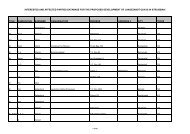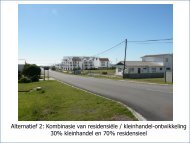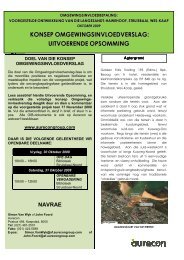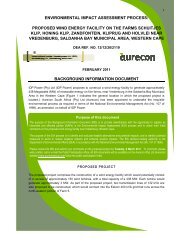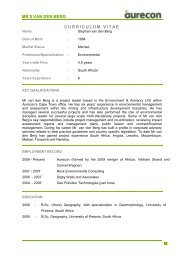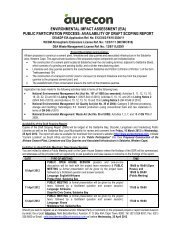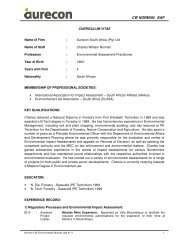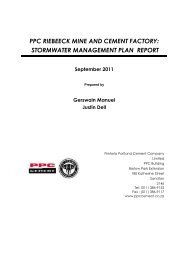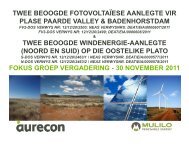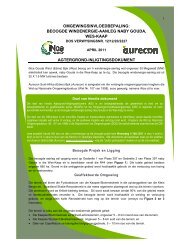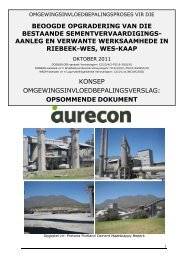Final EIAR - Aurecon AME Environmental | Environmental Projects
Final EIAR - Aurecon AME Environmental | Environmental Projects
Final EIAR - Aurecon AME Environmental | Environmental Projects
You also want an ePaper? Increase the reach of your titles
YUMPU automatically turns print PDFs into web optimized ePapers that Google loves.
Proposed Wind and Solar (Photovoltaic) Energy Facilities on Kangnas Farm near Springbok in the Northern Cape: Draft EIR 87<br />
4 788 MWWhen considered with regards to climate change and given the spirit of the Kyoto<br />
Protocol, the impact is deemed to be of regional extent, very low magnitude and long term and<br />
therefore of low (+) significance for both the proposed wind and solar energy facilities, without<br />
mitigation.<br />
c) Mitigation measures<br />
No mitigation measures are recommended.<br />
d) Cumulative impacts<br />
Many wind and solar energy facilities are proposed throughout the Northern Cape and South<br />
Africa. Although not all those proposed will be constructed, a large number will be operating in<br />
the next few years. Given the number of wind and solar energy facilities proposed across the<br />
country, the potential cumulative impacts of the proposed projects on the potential reduction in<br />
future greenhouse gas emissions is considered to be of regional extent, low magnitude and long<br />
term, and therefore of medium (+) significance.<br />
4.3.3 Impact on local and regional economy<br />
The Northern Cape region of Southern Africa has been identified as producing levels of sunlight<br />
which is ideal for solar energy plants as well as sufficient wind for wind farms. In light of the<br />
current energy crisis and the pressure on the country to increase its share of renewable energy<br />
the opportunities for private renewable energy producers to supply Eskom power grid with<br />
energy is becoming more financially feasible. In light of the proposed wind and solar energy<br />
facilities a Socio-Economic Impact Assessment was undertaken by Urban-Econ (included in<br />
Annexure L). Background information was gathered through a literature review. A site visit was<br />
conducted from 27-29 June 2012. Modelling was undertaken to determine the economic<br />
impacts of the proposed development using Input-Output modelling. The economic findings and<br />
recommendations of the Socio-Economic Impact Assessment are discussed below.<br />
a) Description of the environment<br />
The Nama Khoi Local Municipality (LM) covers a geographical area of 14 921 km 2 which is<br />
approximately 12 % of Namakwa District Municipality. The municipality has a population density<br />
of 3.9 people per km 2 and a household density of 1.1 households per km 2 in 2012. This indicates<br />
that the communities are very dispersed. The total population equates to approximately 1.1<br />
million and a total of 277 551 households within the Nama Khoi municipal area. The town of<br />
Springbok has the largest population. The majority of households are housed in a permanent<br />
house or brick structure. This is a positive indicator in terms of the development levels and<br />
quality of life in the area.<br />
The majority of the adult population in Nama Khoi LM have some education but did not obtain<br />
their Grade 12. This means that the majority of the adult population have a low skill level and<br />
would either need job employment in low-skill sectors, or better education opportunities in order<br />
to improve the skills level of the area, and therefore their income levels. The majority (48.6 %) of<br />
© <strong>Aurecon</strong> (2012) No unauthorised reproduction, copy<br />
or adaptation, in whole or in part, may be made.<br />
P:\<strong>Projects</strong>\108495 Kangnas WEF & PV EIA's\3 Project Delivery\4 Reports\FEIR\FEIR 210213 <strong>Final</strong>.doc


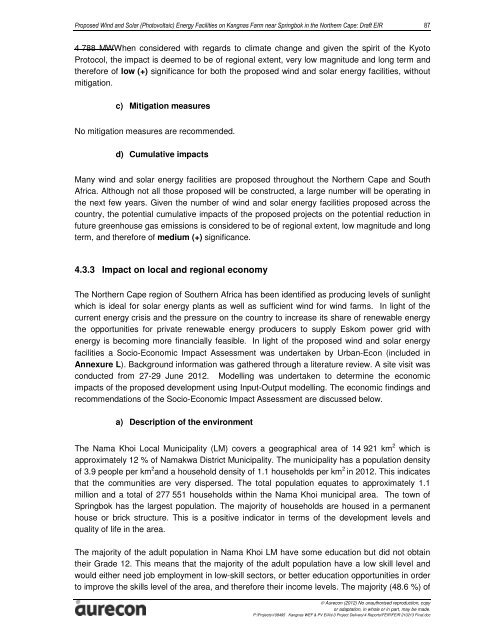
![CRR IV FEIR ~ 26042010 [FINAL].pdf - Environmental Projects](https://img.yumpu.com/21973020/1/184x260/crr-iv-feir-26042010-finalpdf-environmental-projects.jpg?quality=85)
